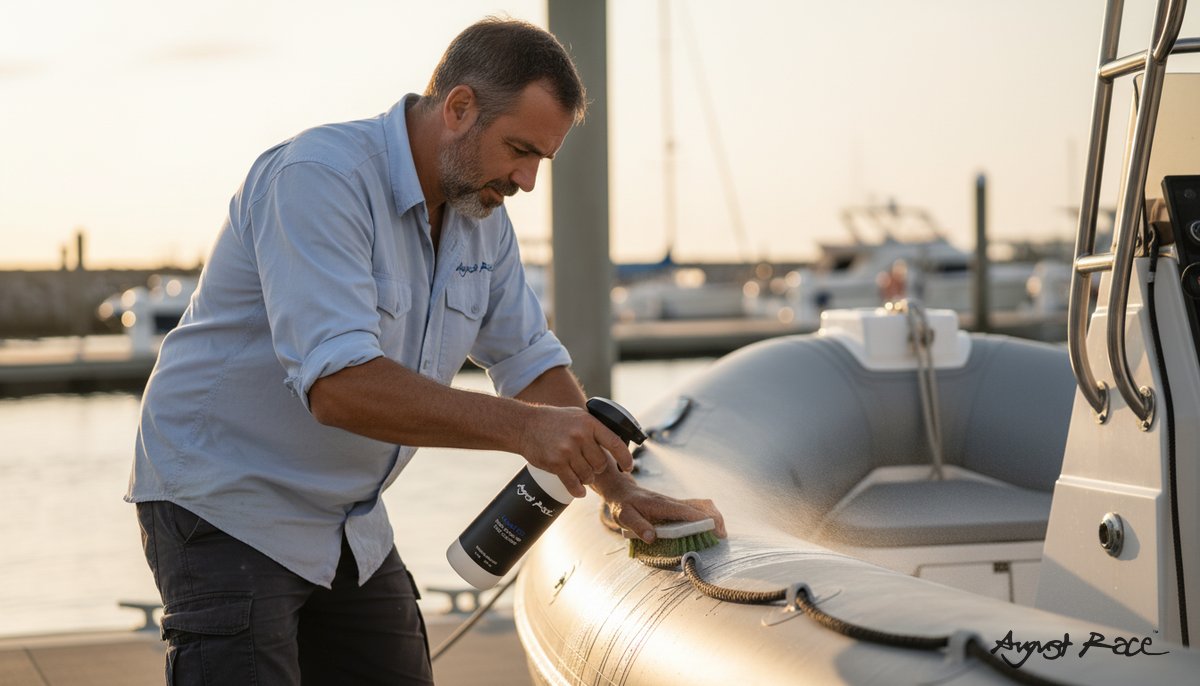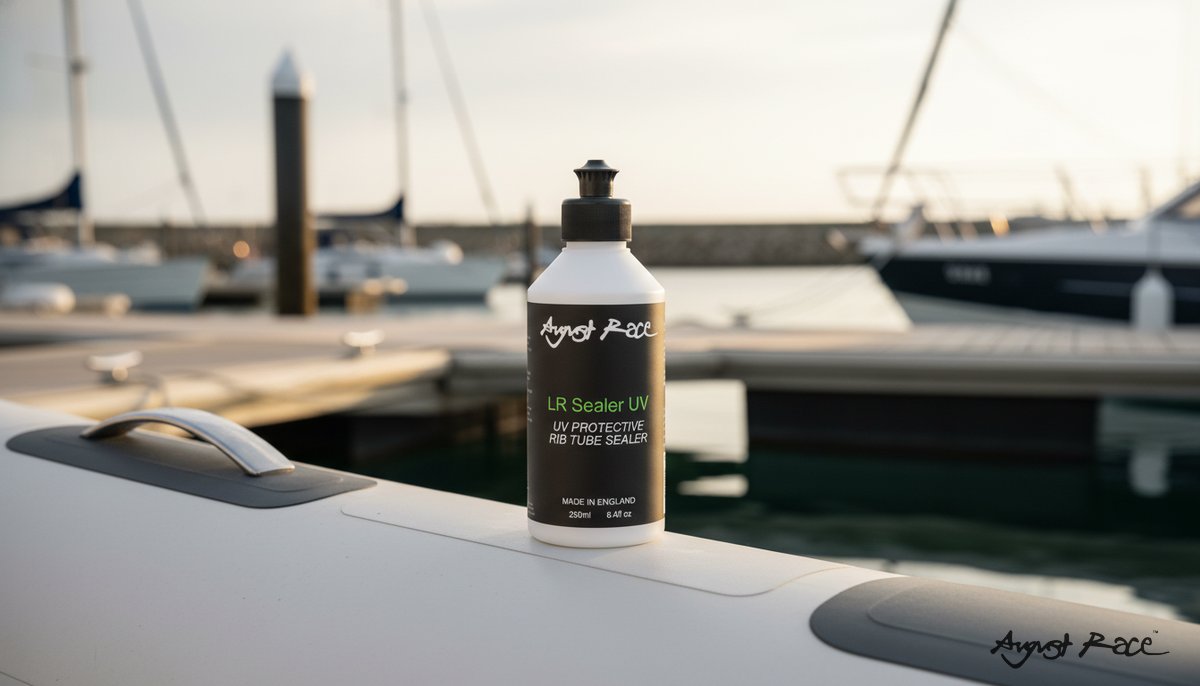How to Prevent UV Cracking Tubes and Protect RIBs with LR Sealer UV
Quick Answer
- August Race LR Sealer UV creates a flexible, UV-resistant barrier that helps reduce PVC and Hypalon tube fading, cracking, and seam degradation in sunny climates.
- Apply to clean, dry seams and tube surfaces as part of routine maintenance to limit inflatable seam damage and extend service life.
- For best results, prep the surface, follow manufacturer dry-time guidance, and reapply seasonally -- before periods of intense sun or winter storage.
If you run a RIB or inflatable in bright sun, you’ve likely seen the signs: RIB tube fading, chalky surfaces, and small splits that become UV cracking tubes. UV exposure attacks both PVC and Hypalon, and seams take the brunt of expansion, flex, and heat. This guide explains how LR Sealer UV fits into a practical maintenance plan to slow damage, protect seams, and keep tubes looking and performing better, longer. It also covers how to extend life of PVC dinghy tubes with clear, step-by-step care.
Learn more in the related guide: RIB UV Protection: How LR Sealer UV Protects Tubes.
Why UV Damage and Fading Matter for RIBs and Inflatable Tubes
- Prolonged UV exposure breaks down polymers in PVC and Hypalon. Over time, this leads to color loss, surface embrittlement, and microcracking. Fading isn’t just cosmetic -- it signals material degradation that can set the stage for bigger problems.
- Seams and high-stress areas are more vulnerable. Heat, flexing, and pressure concentrate at joins and overlaps, which accelerates wear. Once seam damage starts, air loss and structural failure can follow more quickly.
- In sunny climates, typical failure modes include uneven RIB tube fading, chalking, and hairline cracks that expand with flex and pressure. Visible fading often correlates with reduced flexibility -- an early warning to act before repairs get costly.
Sealers are a practical preventative step. By adding a UV-resistant, flexible layer, you can slow the rate of deterioration and help maintain tube integrity between full refurbishments or professional repairs.
What LR Sealer UV Does: Technical benefits for PVC and Hypalon
LR Sealer UV is designed to support PVC protection and assist in preventing UV damage on Hypalon inflatables through a protective film that resists sunlight and weather.
Key functions:
- UV defense: The cured coating forms a barrier that helps absorb and reflect harmful UV, reducing surface oxidation and color fade.
- Flex-friendly: The film remains flexible to move with tubes as they inflate, deflate, and flex underway -- important to minimize stress-related cracking.
- Seam-focused adhesion: Applied correctly, the sealer wets out over stitched and glued seams to help shield exposed edges where degradation often begins.
Compatibility notes:
- Suited for PVC and Hypalon surfaces commonly found on RIBs and dinghies. Always clean thoroughly and use a test patch on a discrete area to confirm appearance and adhesion.
- Older, weathered tubes may benefit from light abrasion or a compatible primer, following product guidance. If a previous coating is present, confirm chemical compatibility.
Expected results when applied correctly:
- Reduced fading and chalking across panels.
- Delayed onset of microcracking in high-sun conditions.
- Extended seam life by limiting UV exposure at overlaps and margins.
Step-by-step: Applying LR Sealer UV to Prevent Inflatable Seam Damage
Use this workflow to get consistent results and help prevent inflatable seam damage, especially if you’re looking for the best sealer for boat tube seams in sunny climates.
- Prep: Clean thoroughly
- Rinse away salt and grit. Use a manufacturer-approved cleaner to remove oils, sunscreen, oxidation, and grime. A targeted option is Liquid RIB cleaner for inflatable tubes; for broader washdowns, consider August Race Boat Wash Pro.
- Dry completely. Moisture under the coating can inhibit adhesion.
- Test patch. Choose a small, hidden area to check colorfastness, sheen, and feel after curing.
- Surface prep: Promote adhesion
- For aged or chalky surfaces, lightly abrade per product guidance (fine Scotch-Brite or equivalent). You’re aiming to remove oxidation, not gouge the fabric.
- Wipe down with a recommended surface prep solvent if directed by the manufacturer.
- If specified, use a compatible primer -- especially on older PVC or previously coated areas -- to improve bond.
- Application: Conditions, tools, and technique
- Conditions: Work between moderate temperatures (commonly 10–25°C/50–77°F), low humidity, and out of direct sun and wind. Shade reduces flashing and helps even film build.
- Tools: Use a clean foam roller or soft brush for panels; a small brush or squeegee for seams and edges.
- Technique: Apply thin, even coats. Avoid heavy loading that can sag or trap solvent. On seams, overlap onto both sides of the join to encapsulate the margin. Maintain a wet edge to minimize lap marks.
- Coverage: Follow label guidance and plan enough material for all UV-exposed areas, prioritizing the gunwales, bow, and topsides. Refer to the product page for specifics: RIB tube UV protective coating.
- Curing: Dry times, handling, and safety considerations
- Dry-to-touch and recoat windows vary by temperature and humidity. Follow the product label; many marine sealers recommend staged recoats within a specified time frame.
- Avoid stress until fully cured. Limit inflation changes, loading, or tight mooring lines on freshly coated seams.
- Use gloves and eye protection. Ensure ventilation if working indoors. Keep away from sparks and open flame. Dispose of solvent-laden rags per local regulations.
- Recoat schedule: Keep protection active
- Inspect monthly during peak sun. Reapply to high-wear zones if water no longer beads, gloss dulls, or surfaces feel dry.
- In sunny climates, seasonal reapplication is typical -- before high-sun months and again before storage -- to maintain coverage.
- For boats in constant use or in tropical UV, plan more frequent touch-ups on bow panels, topsides, and boarding areas.
Performance, Longevity, and Troubleshooting: What to Expect
How long protection lasts depends on climate, exposure hours, salt spray, abrasion, and storage. In moderate conditions, a seasonal application can provide visible UV protection through a boating season with periodic touch-ups. In high-UV or tropical environments, expect shorter intervals between inspections and reapplication for robust PVC protection.
Common issues and fixes:
- Peeling at edges: Usually prep-related. Improve adhesion by removing oxidation, cleaning thoroughly, and recoating within the recommended recoat window.
- Color shift or uneven sheen: Often from uneven film build or surface contamination. Lightly abrade, clean, and recoat thin and even.
- Tackiness after curing: Can result from heavy coats or low ventilation. Allow additional cure time; if needed, remove soft film in a small test area and reapply thinner coats.
Inspection checkpoints:
- Gloss and feel: A dry, chalky feel or flat sheen suggests the coating is thinning.
- Seams and overlaps: Look for whitening, edge lifting, or cracking. If cracks run through the fabric or adhesive, consult a professional.
- Air retention: Repeat air loss after topping up may indicate seam or valve issues beyond the scope of a topical sealer.
For broader context on UV exposure and care routines, see: RIB UV Protection: How LR Sealer UV Protects Tubes.
Seasonal Strategies: Winter Prep and Ongoing UV Protection for RIBs
Applying a UV sealer before winter storage helps in two ways: it shields against shoulder-season UV on bright days and reduces moisture ingress that can worsen freeze–thaw stress. Consider it essential winter prep for UV protection on RIBs. This supports color retention and flexibility when you uncover in spring.
Pre-storage checklist:
- Clean and dry the tubes thoroughly.
- Apply LR Sealer UV and allow full cure per label.
- Partially deflate to reduce seam stress; avoid creasing.
- Store off the ground, covered, and out of direct sun if possible.
- Keep ventilation in mind to prevent condensation buildup.
Spring launch routine:
- Inspect for RIB tube fading, chalking, or dull patches.
- Touch up high-sun surfaces and seams before the first long outing.
- Confirm valves and seams hold pressure over 24 hours before heavy use.
Compatibility, Safety, and When to Seek Professional Repair
Before a full application, confirm compatibility to support preventing UV damage on Hypalon inflatables and PVC alike.
- Do a test patch in a low-visibility area. Check for softening, staining, or poor adhesion.
- Confirm no adverse reaction with prior dressings, waxes, or coatings. Remove incompatible layers.
- Follow PPE guidance, ensure ventilation, keep away from ignition sources, and dispose of wipes and rags according to local rules.
Seek professional help when:
- You see large seam separations, structural delamination, or fabric tears that extend beyond the top layer.
- The tube won’t hold air or loses pressure repeatedly after basic checks.
- Adhesive failures appear along long seams or around transom joints -- these require proper bonding, not just a surface sealer.
Next Steps: Maintain Tube Integrity with a Seasonal Plan
To get ahead of UV and extend life, schedule a maintenance check now. Clean thoroughly, inspect seams, and apply LR Sealer UV before peak sun or long-term storage. For product specifications, review the product page above or browse August Race products.
If you discover damage beyond a topical fix, consult a certified inflatable repair service or visit the August Race official site for more resources. Seasonal, preventative work is more cost-effective than late-stage fixes -- and a simple routine makes it easier to prevent UV cracking tubes before problems spread.
Frequently Asked Questions
Below are concise answers to common questions to reinforce best practices and keep your tubes protected.
How often should I reapply a UV sealer to PVC dinghy tubes in sunny climates?
In high-UV regions, a seasonal application is a practical baseline, with monthly inspections during peak sun. Touch up high-wear areas when gloss drops, water stops beading, or the surface feels dry.
Can LR Sealer UV be used on Hypalon inflatables and will it affect color or flexibility?
Yes, August Race LR Sealer UV is compatible with Hypalon as well as PVC when used as directed. Always perform a small test patch to verify final sheen and feel; the cured film is designed to remain flexible when properly applied.
What surface prep is required to prevent inflatable seam damage when using a sealer?
Clean thoroughly to remove salt, oils, and oxidation, let dry fully, and consider light abrasion on aged surfaces. Where specified, use a compatible primer, and focus extra care on seams and overlaps to promote strong adhesion.
Will applying a UV sealer before winter storage help protect my RIB tubes?
Yes. A cured UV barrier provides protection during bright winter days and helps limit moisture ingress that can worsen freeze–thaw stresses. Apply before storage, allow full cure, partially deflate, and store out of direct sun if possible.
What signs mean I should seek professional repair instead of relying on a topical sealer?
Consult a professional for large seam separation, delamination, or repeated air loss, as these indicate structural issues beyond a surface coating. Persistent leaks or visible adhesive failures at long seams require proper bonding and repair procedures.
About the Author
August Race Team
The August Race professional team brings decades of marine industry expertise and product development knowledge.
Get Expert Tips
Subscribe for marine care insights and product updates from industry professionals.
No spam. Unsubscribe anytime.
You May Also Like

Will WD-40 remove water spots? | Liquid Rib
Short answer: WD-40 can lift some water spots but it is not ideal for RIB tubes. Use August Race Liquid Rib for safer cleaning and lasting protection.

Restore Hypalon Oxidation & Carbon Buildup on RIB Tubes
Clear oxidation, carbon, and trailering grime from Hypalon RIB tubes. Steps, safe cleaners, and 2025 prep to prevent inflatable dullness.

RIB UV Protection: How LR Sealer UV Protects Tubes
Guide to RIB UV protection using LR Sealer UV -- PVC tube sealer and Hypalon UV treatment to prevent UV cracking and reduce cleaning.
